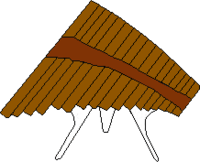Paixiao

The paixiao (traditional: 排簫; simplified: 排箫; pinyin: páixiāo; also pái xiāo, pai-hsiao, pronounced [pʰǎɪ̯ɕi̯ɑ́ʊ̯]) is an ancient Chinese wind instrument, a form of Pan flute. It is no longer used, having died out in ancient times, although in the 20th century it was reconstructed. A major difference between the Chinese Paixiao and the panpipes used in European and South American traditions, is that at the top of the Chinese instrument the pipe holes are each cut angled or with notches. This allows for bending the pitch in similar capacity to the dongxiao down a minor second. This allows Chinese paixiao to be fully chromatic without loss in timbre, even though the included pipes are tuned diatonically.
In Korea, an instrument called the so (hangul: 소; hanja: 簫) was derived from the paixiao and used in ritual music.
A musician named Gao Ming (高明) plays a version called the paidi in the Tang Dynasty Music and Dance Show at the Shaanxi Grand Opera House in Xi'an; he has been a member of this ensemble since 1982. While his instrument superficially resembles the instrument used during the Tang Dynasty, its pipes have ducts rather than being end-blown, it is played with the pipes held horizontally rather than vertically, and it is set up to play in parallel thirds.video